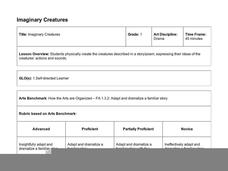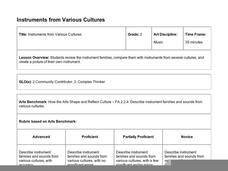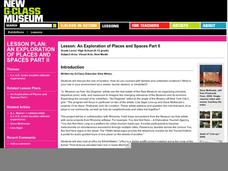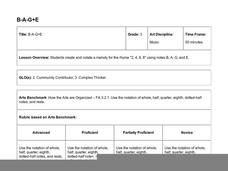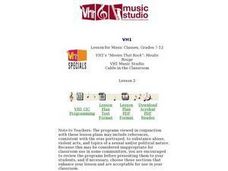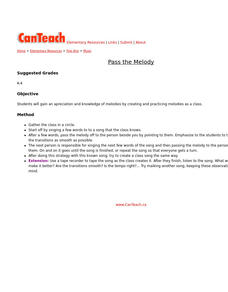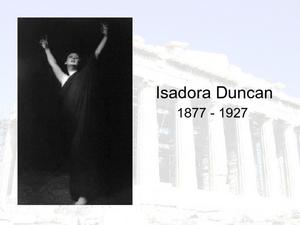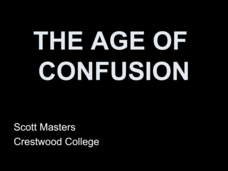Asian Art Museum
Defining "Home"
Open-ended dialogue and guiding questions lead children through a discussion about the relationship between physical objects and personal identity. They analyze the work of two contemporary Japanese artists who have use their mediums to...
Hawaiʻi State Department of Education
Imaginary Creatures
Drama and movement are wonderful ways to cover story elements such as setting, character, and descriptive writing. Little ones listen to a poem about imaginary creatures. As they listen, they shape their bodies into what they think the...
Hawaiʻi State Department of Education
Instruments from Various Cultures
After a review of orchestral instruments and instrument families, learners make their own. They listen to the song "Simple Gifts" and identify the instruments heard in the piece. Then they draw an instrument of their own invention,...
Hawaiʻi State Department of Education
Mask Symmetry
When you engage learners in creating symmetrical objects you are also building their vocabulary and math sense. Kids discuss key words such as, asymmetrical, symmetrical, balance, tint, and shade. They use these elements of design to...
New Class Museum
Lesson: An Exploration of Places and Spaces Part II
How does your location alter or impede your movement? An interesting question posed by two artists, who work to show the restrictions of people in various landscapes. Learners analyze both exhibitions, discuss location and movement, then...
New Class Museum
Lesson: Elizabeth Peyton: Portraits: Androgyny in Contemporary Culture
Portraiture, artistic expression, romanticism, and androgyny are discussed in a thought-provoking lesson. Upper graders first discuss and examine the history of portraiture and the elements common to the Romantic style. Then they turn...
Hawaiʻi State Department of Education
Pilobolus
After reviewing dance-specific terminology and watching a clip from the dance troupe Pilobolus, learners create dances of their own. They pair up and use the teacher's cues to create creature dances that exemplify mood and shape. Any...
Hawaiʻi State Department of Education
B-A-G+E
Budding musicians discuss rhythmic notation and melody as they play a bar instrument or recorder. They use the notes B, A, G, and E to play a simple melody, and then they use those same four notes to turn a poem into a song. They play...
San Francisco Symphony
Instrument and Visual Appreciation of Art
There are a lot of great ideas to be found here. To better understand the connection between art and history, learners research several music and art pieces, then relate them to major social events. They study the lives and works...
Hawaiʻi State Department of Education
Suki's Kimono
In the story Suki's Kimono drums are used to show mood. Learners discuss mood in the story after they practice playing a simple 4/4 rhythm on their drums. Each group plays the rhythm using a different tempo. They listen to each other...
Hawaiʻi State Department of Education
Comparing Cultural Dances
All cultures express similar thoughts, feelings, and ideas. But, often times those things are expressed differently. Learners compare and contrast traditional dances from two cultures. They watch videos of each performance, stop to...
Japan Society
Japanese Architecture for High School Students
Japanese architecture is rich in symbolism and culture. Critical thinkers engage in three activities intended to expose them to the beauty of Japan. They read through the book, Praise of Shadows by Junichiro Tanizaki and watch the film...
Hawaiʻi State Department of Education
Theme and Variation
The dance elements of body, energy, space, and time are the focus of a lesson on movement and theme. The class follows along as the teacher shows them a new dance that has a theme. They practice the dance, and then change one element in...
VH1
Lesson 2: Moulin Rouge
The pop movie Moulin Rouge was based on the opera La Boheme. Learners watch the last 30 minutes of each musical to compare and contrast social opposites. They'll first discuss the social differences of the main characters and how those...
Incredible Art Department
Notan Collages - "Expanding the Square"
Notan is a Japanese word that expresses the interaction between light and dark. Learners explore Notan while creating dimensional art pieces that examine positive and negative spaces. They'll discuss the art of Notan, create their...
Mrs. Lindberg
Georgia O'Keefe
Introduce the art of Georgia O'Keefe to you class. Here, you'll find brief information about her life and art style, as well as eight of her famous flower paintings. Learners will be able to analyze the organic shapes and colors she used...
Can Teach
Pass the Melody
Get a jam session started in your elementary music class! Learners engage in melody transitions by singing a familiar song and passing on the tune to the next person.
Curated OER
Making a Simple Carving Polynesia Leg from the Marquesas Islands
Students discuss tribal art and engage in the design process. In this art analysis and design lesson students look at a photograph of a carved Polynesian Leg and describe the shapes and patterns they see. They then carve a piece of soap...
Curated OER
Ships 3: Grand Designs And Great Failures
Students engage in this, the third in a three-part series on ships. The overall lesson series is designed to allow students to extend their understanding of floating, sinking, density, and buoyancy and apply it to the design and testing...
Curated OER
Flip and Flop: An Adaptation Through Dancing Echoes with Shapes and Locomotor Movement
Dancers practice echoing through dance. They listen to a story "Flip and Flop" and then are put into pairs. One partner is Flip, while the other is Flop. Flip creates a shape by dancing, and Flop, the other student, echoes that shape by...
Curated OER
Isadore Duncan
Who is Isadore Duncan? If you're a teacher of dance, you might be interested in this informative presentation. Biographical, philosophical, and personal information on the life and contributions of this famed dancer are given in an easy...
Curated OER
Great Balls of Fire - I Got Locomotor Skills
Teach and review elementary locomotor skills. Use "Great Balls of Fire" by Jerry Lee Lewis to get youngsters up and grooving to the beat! The dance steps are described in rich detail and you will have the class jumping, skipping,...
Curated OER
The Age of Confusion
According to the presentation, the age of confusion was marked by a very specific set of art and philosophical movements. Take a visual trip, and explore expressionism, cubism, Dada, Bauhaus, existentialism, and the new modes of...
Curated OER
Surfin' USA Lummi Stick Routine
"Let's go surfin' now, everybody's learning how, come on and safari with me." One of the Beach Boys more famous songs that is bound to get your class up and moving. This dance has basic dance steps and the added dimension of using Lummi...



